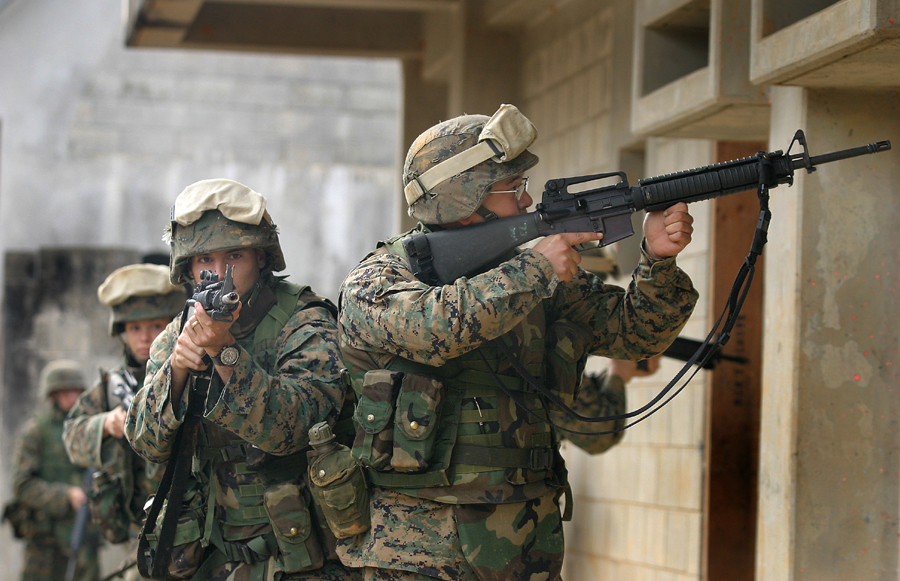The authority to deploy the U.S. military inside the USA was established first in Article IV of the Constitution in cases of domestic violence that threaten the government of a state, or the application of federal law. This authority was further clarified both by the Insurrection Act of 1807 and the Posse Comitatus Act of 1878.
The Insurrection Act specifies the circumstances under which the president may convene the armed forces to suppress an insurrection against any state or the federal government. Furthermore, where an individual state is concerned, consent of the governor must be obtained prior to the deployment of troops. The Posse Comitatus Act gives some teeth to the Insurrection Act by provides penalties for unlawful troop deployments.
Loophole for initiating martial law
Listed on the Pentagon's website, DoD Directive 3025.18: Defense Support of Civil Authorities (DSCA) seems to enhance the circumstances in which the military may be deployed for situations inside domestic U.S. territory.
The recent Pentagon directive seems to creep into new territory - that military force may be applied without civilian introduction. Quoted in full context (see Page 5), the vague language reads as follows:
This section is not a restatement of previously established law, as a casual reader might conclude. It poses several problems, and is dangerously vague.i. Federal military commanders are provided EMERGENCY AUTHORITY under this Directive. Federal military forces shall not be used to quell civil disturbances unless specifically authorized by the President in accordance with applicable law (e.g., chapter 15 of Reference (d)) or permitted under emergency authority, as described below (see DoDD 3025.12 (Reference (j)) and DoDD 5525.5 (Reference (c))).
In these circumstances, those Federal military commanders have the authority, in extraordinary emergency circumstances where prior authorization by the President is impossible and duly constituted local authorities are unable to control the situation, to engage temporarily in activities that are necessary to quell large-scale, unexpected civil disturbances because:
(1) Such activities are necessary to prevent significant loss of life or wanton destruction of property and are necessary to restore governmental function and public order; or,
(2) When duly constituted Federal, State, or local authorities are unable or decline to provide adequate protection for Federal property or Federal governmental functions. Federal action, including the use of Federal military forces, is authorized when necessary to protect the Federal property or functions.
The directive gives "federal military commanders" a loophole to assume presidential authority to deploy troops. And just who are they? The Long Island Press obtained this definition:
The document does not attempt to define what circumstances would be so severe that presidential authorization becomes "impossible" to obtain. The law already establishes a chain-of-authority so that executive power is contiguous, even in the event of a president's death.According to the defense official, a commander is defined as follows: "Somebody who's in the position of command, has the title commander. And most of the time they are centrally selected by a board, they've gone through additional schooling to exercise command authority."
The language seems to leave it up to the interpretation of the federal military commanders to decide if presidential authorization is impossible. If an "emergency" arises and a commander and is unable to contact the president, the Pentagon's directive seems to allow the deployment of troops without civilian input. This would be a break from centuries-old doctrine that keeps the military under civilian control.
The commander also seems to be trusted in exercising judgement as to determining what constitutes an "emergency" where the vaguely defined acts of "significant loss of life" or "wanton destruction of property" are taking place. These concepts are dangerously vague, and leave all sorts of open doors and unanswered questions.
"These phrases don't have any legal meaning," said Bruce Afran, civil rights attorney. "It's no different than the emergency powers clause in the Weimar constitution [of the German Reich]. It's a grant of emergency power to the military to rule over parts of the country at their own discretion."
As one defense official told the Washington Times, "this appears to be the latest step in the administration's decision to use force within the United States against its citizens."
Fighting the War on Terror at home
Directive 3025.18 further states that military surveillance drones - called unmanned aircraft systems (UAS) - may be deployed for domestic purposes with the express approval of the Secretary of Defense. (Page 6)
A supplementary instruction document from the Pentagon lays out the conditions for the military to operate on American streets while fighting the War on Terror. (Read it here: DoD Directive 3025.21: Defense Support of Civilian Law Enforcement Agencies)
In a section titled "DOMESTIC TERRORIST INCIDENT SUPPORT," the Pentagon document states that "the Secretary of Defense may authorize the use of DoD personnel in support of civilian law enforcement officials during a domestic terrorism incident."
Military commanders, including those at USNORTHCOM, USPACOM, and USSOCOM, would be granted the authority over "operations, including the employment of armed Federal military forces at the scene of any domestic terrorist incident."
While the government has historically had ample discretion in declaring martial law, these recent changes appear to open up even further opportunities for wholesale suspension of civilian rights.




Reader Comments
to our Newsletter